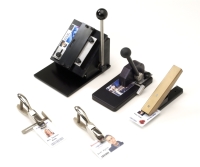 HID card-based access control systems consist of four main compents. These are: HID Cards, card readers, access controllers and the host access control software program.
HID card-based access control systems consist of four main compents. These are: HID Cards, card readers, access controllers and the host access control software program.
HID prox cards – Access control cards have embeded information inside that consist of a number of binary numbers. This information identifies the card holder to the access system. There are many configurations available with these cards that are used for different applications and provide security. Different options available can be used alone or in combination. Some of these options are iClass contactless smart cards, MIFARE, magnetic stripe, Wiegand and 125 kHx prox.
Card Readers – Card readers are designed to obtain the embedded information from the HID card and transmit it to the controller. The card reader is specific to the type of card that is set to the facility and cards that apply to the operation. The binary code is aquired, converted to a readable format and transmitted quickly for a access response.
Access Controllers – The control is where the granted access is provided or denied. The controller accepts the data sent from the card reader and it processes the data. By reviewing the length of the code and by reviewing it’s seperate parts, the controller scans the database for exact matches. If found, the controller allows access to be granted.
Access Control Software Program – This program is controlled by security personnel to authorize specific cards for specific access. Restrictions and privileges can be granted to specific card holders for various authorization and specific times. The program also allows personnel to change the configuration of the access control hardware so that various doors and security needs can be authorized. It is through this program that the doors can be monitored and reporting can be generated for managment needs.
Find out more information about HID card best practices.

 A slot punch provides the rectangular slot in the printed plastic ID badge so that it can be worn by use of a badge attachment such as a lanyard or badge reel. The punch will provide a consistent hole in a PVC card or an HID prox card without cracking the card.
A slot punch provides the rectangular slot in the printed plastic ID badge so that it can be worn by use of a badge attachment such as a lanyard or badge reel. The punch will provide a consistent hole in a PVC card or an HID prox card without cracking the card.